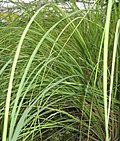| Plant | Image | Pests |
|---|
| Artemisias |  | repels insects, [2] including ants, cabbage looper, cabbage maggot, carrot fly, codling moth, flea beetles, whiteflies, the Cabbage White, and the Small White, as well as mice [3] |
| Basil |  | repels flies, including mosquitoes [2] [4] the carrot fly, asparagus beetles and whiteflies [3] |
| Borage |  | repels tomato hornworm and cabbage worms [2] |
| Castor bean |  | repels moles [3] |
| Catnip |  | repels ants, flea beetles, aphids, the Japanese beetle, squash bugs, weevils, [2] the Colorado potato beetle, the cabbage looper, [3] and cockroaches. [4] May attract cats. |
| Chamomile |  | repels flying insects [4] |
| Chives |  | repels carrot fly, Japanese beetle, [2] and aphids [3] |
| Chrysanthemums |  | repel roaches, ants, the Japanese beetle, ticks, silverfish, lice, fleas, bedbugs, and root-knot nematodes [2] |
| Citronella grass |  | repels insects, may deter cats [5] |
| Clovers |  | repel aphids and wireworms [3] |
| Common lantana |  | repels mosquitoes [1] |
| Coriander |  | repels aphids, Colorado potato beetle, and spider mites [3] |
| Cosmos |  | repel the corn earworm |
| Crown imperial |  | repel rabbits, mice, moles, voles and ground squirrels [6] |
| Dahlias |  | repel nematodes [2] |
| Dill |  | repels aphids, squash bugs, spider mites, [2] the cabbage looper, and the Small White [3] |
| Epazote |  | repels spider mites, [7] thrips, aphids, and whitefly [8] |
| Eucalyptus |  | repels aphids, the cabbage looper, and the Colorado potato beetle [3] |
| Fennel |  | repels aphids, slugs, and snails [3] |
| Lantana ukambensis | | repels mosquitoes [1] |
| Four o'clocks |  | attract and poison the Japanese beetle [2] |
| French marigold |  | repels whiteflies, kills nematodes [2] |
| Garlic |  | repels root maggots, [2] cabbage looper, Mexican bean beetle, and peach tree borer. |
| Geranium |  | repel leafhoppers, the corn earworm, and the Small White [3] |
| Hyssop |  | repels the cabbage looper and the Small White [3] |
| Larkspurs |  | repel aphids [3] |
| Lavender |  | repels moths, scorpions, water scorpions, fleas, and flies, including mosquitoes [4] |
| Leek |  | repels carrot fly [3] |
| Lemongrass |  | repels mosquitoes [9] |
| Lemon balm |  | repels mosquitoes [4] |
| Lemon thyme |  | repels mosquitoes [4] |
| Lettuce |  | repels carrot fly [3] |
| Lime basil |  | repels mosquitoes [1] |
| Mexican marigold |  | repels insects and rabbits [2] |
| Myrrh |  | repels insects [5] |
| Narcissus |  | repel moles [3] |
| Nasturtiums |  | repel squash bugs, [2] aphids (though there is conflicting information with some sources stating it attracts aphids), [10] many beetles, and the cabbage looper [3] |
| Onion |  | repels rabbits, the cabbage looper, and the Small White [3] |
| Oregano |  | repellent to many pests [3] |
| Parsley |  | repels asparagus beetles [3] |
| Peppermint |  | repels aphids, cabbage looper, flea beetles, squash bugs, whiteflies, and the Small White [3] |
| Petunias |  | repel aphids, tomato hornworm, asparagus beetles, leafhoppers, [2] and squash bugs [3] |
| Pitcher plants |  | traps and ingests insects |
| Radish |  | repels cabbage maggot and cucumber beetles [3] |
| Rosemary |  | repels cabbage looper, carrot fly, cockroaches and mosquitoes, [11] slugs, snails, as well as the Mexican bean beetle [3] |
| Russian sage |  | repels wasps |
| Rue |  | repels cucumber and flea beetles |
| Sarracenia pitcher plants |  | are especially proficient at trapping yellowjacket wasps |
| Spearmint |  | repels fleas, moths, ants, beetles, rodents, [4] aphids, squash bugs, and the cabbage looper [3] |
| Spiny amaranth |  | repels cutworms |
| Stone root |  | repels mosquitoes [5] |
| Summer savory |  | repels bean beetles [3] |
| Tansy |  | repels ants, many beetles and flies, squash bugs, cutworms, Small White, and Cabbage White [3] |
| Thyme |  | repels cabbage looper, cabbage maggot, corn earworm, whiteflies, tomato hornworm, and Small White |
| Tobacco |  | repels carrot fly, flea beetles and worms. [3] |
| Tomato |  | repels asparagus beetles [3] |
| Venus flytrap |  | ingests insects [4] |
|























































